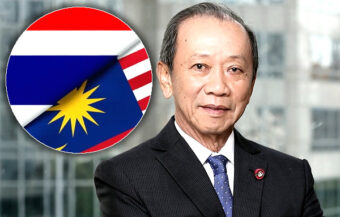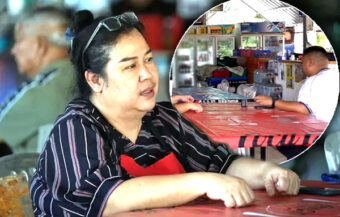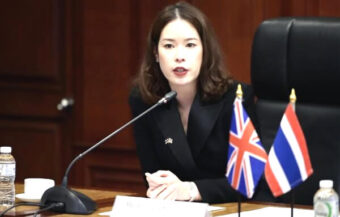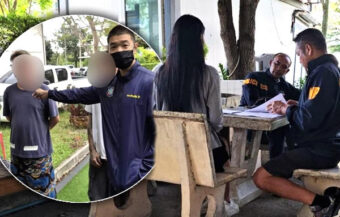Thailand’s new government is pushing closer ties with China through a major rice deal, tourism initiatives, and trade talks, raising concerns over U.S. relations as Bangkok navigates a risky geopolitical balance between Beijing and Washington in the region.
Since taking office last week, Prime Minister Anutin Charnvirakul has signalled his government’s eagerness to deepen ties with China. Commerce Minister Suphajee Suthumpun on Sunday urged closure on a key government-to-government deal for 280,000 tons of Thai rice, while top ministers on Friday met Chinese Ambassador Zhang Jiangwei to boost tourism and agricultural exports. On the same day, Anutin reaffirmed Thailand’s commitment to closer integration with China at a high-profile event in Muang Thong Thani. Yet these moves have sparked concerns over the U.S.-Thailand trade deal and the kingdom’s relations with its longtime defence ally. In the Trump-era climate, playing both sides is riskier than ever, leaving Thailand to navigate a more difficult and precarious path between Beijing and Washington.
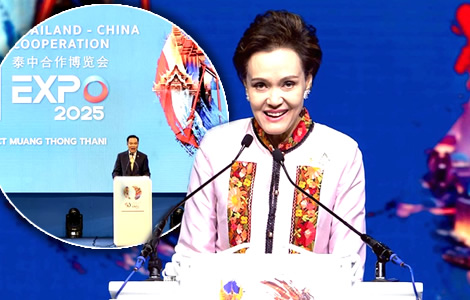
Since the government of Prime Minister Anutin Charnvirakul was sworn in last week, Thailand has emphasised stronger ties with China. On Friday, Prime Minister Anutin delivered a keynote address at the Challenger Impact Centre in Muang Thong Thani. During the speech, he highlighted efforts to accelerate rail connectivity across Southeast Asia.
Furthermore, he described Thailand as a logistics hub for the Communist superpower in ASEAN. Privy Council President Surayud Chulanont attended, along with China’s new ambassador Zhang Jiangwei, Commerce Minister Suphajee Suthumpun and other senior officials.
Thailand emphasises stronger ties with China and positions itself as a key logistics hub in ASEAN countries
Meanwhile, Minister of Tourism and Sports Atthakorn Sirilathayakorn and Deputy Prime Minister and Minister of Agriculture Thamanat Prompow met the Chinese envoy. Their discussions focused on boosting agricultural exports and attracting more Chinese tourists to Thailand.
Moreover, officials noted that Beijing may leverage its tourists to influence policy in target markets. Although this has long been suspected by industry insiders, the recent decline in Chinese tourists may indirectly reflect China’s assessment of Thailand’s previous government.
Nevertheless, security fears and negative social media campaigns remain primary reasons for the decline. These campaigns portray Thailand as a dangerous destination, and they have influenced tourist decisions. Consequently, the government continues to monitor visitor safety while ensuring Thailand remains attractive for international travellers.
On Sunday, Commerce Minister Suphajee Suthumpun urged completion of a government-to-government contract with China to purchase 280,000 tons of Thai rice. This agreement comes amid a global glut in rice, which has challenged Thailand’s export market.
Talks with China focus on boosting tourism and agricultural exports while managing security concerns
Furthermore, she highlighted that trade between Thailand and China reached $96.254 billion in the first eight months of 2025, a 28.1% increase from last year. This growth demonstrates the enduring importance of China as Thailand’s leading trading partner for twelve consecutive years.
Minister Suphajee delivered a special address at the Thailand–China Cooperation Expo 2025, marking fifty years of diplomatic relations. She expressed gratitude to China for being Thailand’s largest importer of agricultural products. In addition, she urged completion of the remaining 280,000 tons of the one-million-ton rice contract under the G2G framework.
She highlighted the symbolic value of the agreement, which strengthens bilateral economic cooperation. She also encouraged Thai citizens to travel during China’s “Golden Week,” emphasising the readiness of both government and people to provide excellent hospitality.
During her speech, Minister Suphajee outlined five areas of strategic Thai-Chinese cooperation. First, infrastructure and logistics connectivity will be enhanced through projects like the Thai–China high-speed rail linking ASEAN with southern China.
Deeper cooperation with China focuses on infrastructure and high-speed rail linking ASEAN with southern China
Second, she emphasised the green economy and clean energy sector, including electric vehicles and battery production. Third, she highlighted digital technology and innovation, including cross-border AI research to support SMEs.
Fourth, she discussed agriculture and food security, focusing on key commodities such as durian, mangosteen, longan, cassava, rubber, and rice. Finally, she stressed people-to-people exchanges in education, culture, and tourism, noting the shared heritage between Thailand and China.
Minister Suphajee also stressed active participation in international trade events. Thai entrepreneurs are encouraged to engage in China’s CIIE 2025 in Shanghai, while Chinese investors are invited to Thai exhibitions such as the Bangkok Gems & Jewellery Fair and THAIFEX – ANUGA ASIA.
Additionally, Thailand maintains eight trade offices in China, including Chengdu, Kunming, Nanning, Guangzhou, Xiamen, Shanghai, Qingdao, and Hong Kong, plus a commercial office in Beijing. These offices facilitate bilateral trade, investment, and business collaboration.
Thailand expands cooperation with China in green energy, tech innovation, agriculture and trade networks
Prime Minister Anutin also stressed Thailand’s growing role in high-tech manufacturing. He highlighted Thailand as a hub for electric vehicle production, semiconductors, and green batteries. Furthermore, he outlined a five-year economic cooperation plan with China spanning 2025 to 2029.
This plan includes upgrading infrastructure, promoting digital innovation, enhancing agriculture, and encouraging cultural and educational exchanges. He emphasised that Thailand is not only China’s economic partner but also a gateway for broader ASEAN cooperation.
Gen Surayud Chulanont echoed these remarks, underlining long-standing friendship based on trust and non-interference. He highlighted historical royal bonds and close people-to-people links, stating, “China and Thailand are not far apart, but brothers.” Such ties reinforce the stability of bilateral relations, even amid shifting geopolitical pressures.
Despite these economic achievements, domestic concerns persist. The March 28 collapse of the Office of the Auditor-General exposed vulnerabilities in Thailand’s industrial and construction sectors.
Domestic challenges persist as Thailand faces economic vulnerabilities amid expanding ties with China
Chinese-owned firms and ‘zero-tariff’ factories have consolidated influence, raising concerns about the exploitation of Thai laws. Public resistance has emerged, lately, for instance, in Prachin Buri, where local residents objected to six Chinese electrical and waste factories. Analysts warn that unchecked expansion of Chinese firms could hollow out Thailand’s economy.
Consequently, ongoing negotiations between the Ministry of Commerce, the Ministry of Finance, and US trade representatives require careful monitoring. The new US ambassador remains before the Senate in Washington, awaiting confirmation.
Observers fear the Anutin government may not maintain the former Pheu Thai administration’s commitment to the 19% tariff deal with the United States. Conservative politicians and farmers are especially vocal in opposing liberalised US pork imports.
The National Swine Raisers Association has prepared a letter requesting clarity from Deputy Prime Minister Thamanat Prompow. Farmers demand confirmation that US pork imports will remain limited, citing domestic production costs higher than international averages.
Chinese investment and US trade talks raise concerns over market stability and pork import policies in Thailand
They warn that liberalisation would destabilise the market, which currently has a 10% surplus. Live pig prices average 46 baht per kilogram, while production costs are ฿68–฿70 per kilogram.
These domestic concerns combine over time with broader geopolitical dynamics. Southeast Asia remains divided into continental and maritime subregions.
Continental countries, including Thailand, Cambodia, Laos, Myanmar, and Vietnam, are increasingly aligned with China. Maritime countries, including Indonesia, Malaysia, Singapore, and the Philippines, maintain diversified partnerships, hedging between China, the United States, and other global powers. Analysts note that this divide will likely grow in the coming decades.
Geography has historically shaped these patterns. Rugged highlands separating China from Laos, Myanmar, and Vietnam prevented full Chinese influence for centuries. Anthropologists refer to these areas as “Zomia,” highlighting their resistance to centralised control. Today, modern infrastructure, railways and economic zones have reduced these barriers, increasing connectivity and Chinese leverage.
Regional alignments show how continental and maritime Southeast Asia sees different Chinese influence
China’s Belt and Road Initiative has financed major infrastructure projects linking continental Southeast Asia to its economy. Railways in Laos and Thailand have increased trade significantly, while pipelines facilitate energy flows.
However, special economic zones have created unregulated spaces, allowing Chinese businesses to operate outside local law. This has led to issues such as migrant labour exploitation, wildlife crime, cyber scams and environmental damage.
Vietnam has also drawn substantial Chinese investment, particularly in the north, as supply chains shift from China. Although northern Vietnam is more industrially developed, southern Vietnam remains a trade hub. The United States imposed a 20% tariff on Vietnamese products, lower than its corresponding tariffs on Chinese goods, attracting further Chinese investment.
In maritime Southeast Asia, infrastructure projects enhance Chinese economic influence but do not create the same dependency seen on the continent of Southeast Asia.
Belt and Road projects boost trade and energy flows while raising regulatory and environmental concerns
Indonesia’s Jakarta-Bandung high-speed railway and Malaysia’s east-west rail project improve connectivity but maintain independent trade networks. Maritime countries, by geography and size, have more diversified economic and security partnerships. They remain less vulnerable to exclusive Chinese influence.
China has attempted to assert control over maritime Southeast Asia, especially in the South China Sea. However, international opposition, including a UN tribunal ruling in 2016, has limited China’s claims.
The United States and its allies have stepped up military cooperation, particularly with the Philippines, to ensure freedom of navigation and respect for international law.
Southeast Asia’s continental states will increasingly fall under China’s economic and strategic influence. Meanwhile, maritime states will retain broader international partnerships, balancing Beijing’s power. Analysts urge the United States to strengthen ties with Thailand and Vietnam, which lie at the margins of China’s continental influence.
Maritime Southeast Asia balances China’s power while continental countries align closer with Beijing
Thailand’s position is crucial for regional stability. Historically, a Cold War United States ally, the country has maintained relationships with both Western and Asian partners. It is still on paper, at least, a US Defence ally.
However, economic and defence ties with China have deepened under recent governments. Washington’s punitive measures, including sanctions related to Uyghur deportations, risk pushing Thailand further into Beijing’s orbit. Strengthening U.S.-Thai relations could preserve Southeast Asia’s balance of power and ensure maritime states remain open to diverse partnerships.
Thailand’s economic relationship with China continues to grow. Minister Suphajee this weekend emphasised China’s role as Thailand’s largest investor in clean energy, advanced electronics, biotechnology, and electric vehicles.
Tourism from China remains vital for economic growth, particularly during the “Golden Week” holiday. The Thai government is committed to ensuring visitor safety, convenience, and high-quality hospitality.
Thailand balances growing economic and defence ties with China while maintaining links to Western partners
Trade promotion remains active at multiple levels. The Ministry of Commerce supports bilateral trade through Asean-China Free Trade Area (ACFTA), Regional Comprehensive Economic Partnership (RCEP) and provincial MOUs. Trade offices and expos facilitate cooperation and ensure Thai and Chinese entrepreneurs can conduct business effectively.
The Thailand–China Cooperation Expo 2025 celebrated fifty years of diplomatic ties, showcasing the depth and sustainability of economic collaboration.
Prime Minister Anutin stressed Thailand’s five strategic cooperation areas: logistics and connectivity, green energy, digital innovation, agriculture, and people-to-people exchanges. These areas highlight shared opportunities and reinforce Thailand’s role as a gateway to ASEAN. By combining infrastructure, technology, and culture, Thailand and China aim to create sustainable, long-term growth.
At the same time, Thailand faces significant domestic and international challenges. US trade negotiations, tariff disputes, and agricultural concerns require careful management.
The government must balance strengthening ties with China and maintaining diversified partnerships. The decisions it makes will influence not only bilateral relations but also the broader development of Southeast Asia’s economic and strategic environment.
Thailand navigates domestic and international challenges while expanding cooperation with China
Thailand’s government is therefore navigating a complex landscape. The challenge lies in balancing foreign engagement, domestic stability, and regional influence. Trade, investment, infrastructure, and cultural cooperation with China are advancing rapidly.
Yet, economic diversification and U.S. partnership remain essential to mitigate overreliance on any single foreign power. The U.S., for instance, is by far Thailand’s most valuable export market. In the Trump era, this could be lost overnight with the wrong move toward China.
Yet Thailand is now deepening its ties with China. Domestic stakeholders, including farmers and industrialists, however, insist on clear policies to protect local interests. Likewise, the United States watches closely, seeking to maintain influence in the Indo-Pacific.
Thailand’s decisions over the coming months are critical. They will certainly signal whether it balances continental pressures with maritime opportunities effectively.
Plan to revise Thai tourism numbers by promoting sports and pivoting towards Asia and the Middle East
Business leaders and bankers urge the government to push through the US Thai tariff deal at all costs
Thailand stands at a geopolitical crossroads. The new government’s commitment and, indeed, enthusiasm for China is evident through infrastructure, trade, and technology cooperation initiatives since the cabinet was sworn in. Yet domestic concerns, U.S. trade relations, and regional strategic dynamics make this a high-stakes environment.
Observers agree that Thailand’s choices will shape its own future in Southeast Asia in the coming decade. It must balance China’s continental influence with opportunities in maritime partnerships and enable economic cooperation with the wider world, particularly the Western world dominated by the United States.
Join the Thai News forum, follow Thai Examiner on Facebook here
Receive all our stories as they come out on Telegram here
Follow Thai Examiner here
Further reading:
Thailand’s once mighty tourism industry is failing but now faces further damage from overvalued baht
Rate cut anticipated as outgoing Bank of Thailand governor attends last Monetary Policy Committee
Last minute tweaks in Bangkok as deal is finalised with U.S. However, Thailand may not match Vietnam

